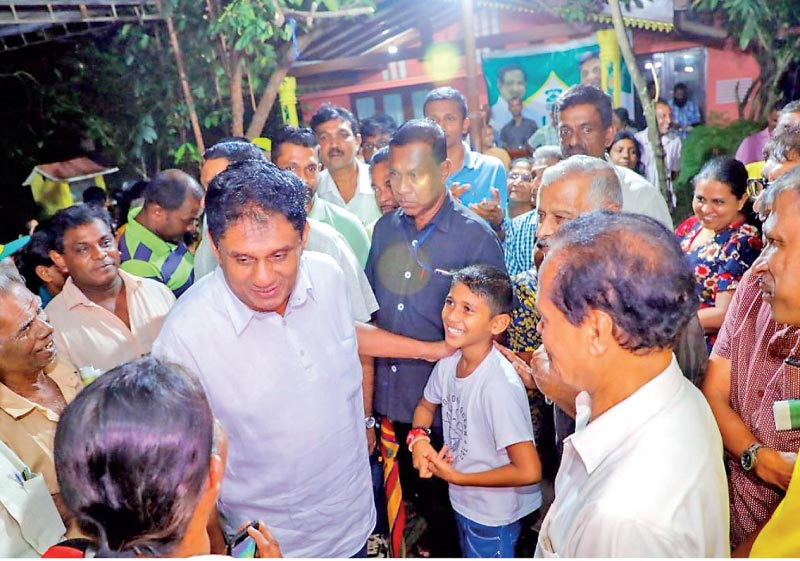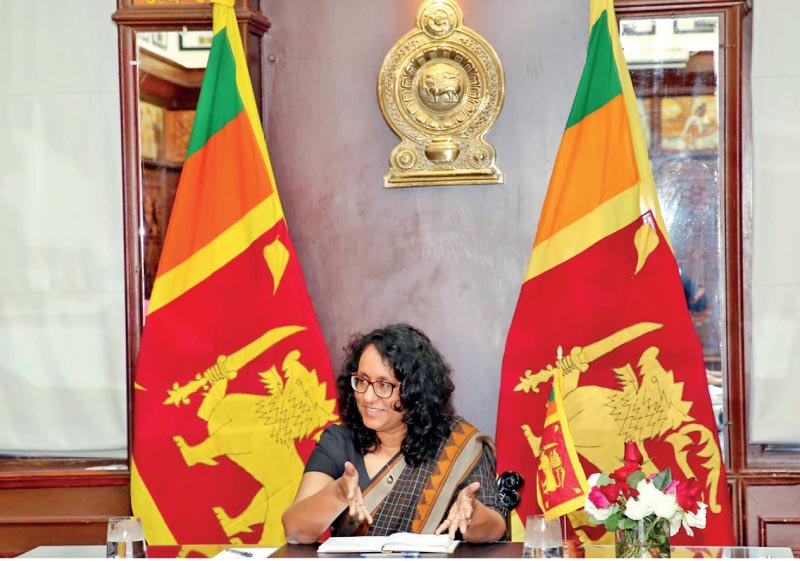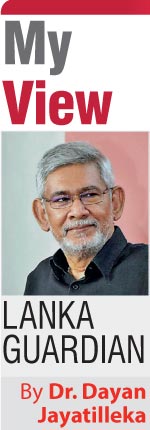Wednesday Dec 10, 2025
Wednesday Dec 10, 2025
Thursday, 7 November 2024 00:40 - - {{hitsCtrl.values.hits}}

Can make a material difference

‘“We aim to leave power only once we have successfully rebuilt this nation” Dissanayake pledged, addressing a rally in Nuwara Eliya…’
(https://www.ft.lk/news/President-outlines-NPP-s-inclusive-vision-for-transformative-change/56-768799)
 Throughout 2024 I consistently urged that the choice be either Sajith or Anura (or vice versa) -- and never Ranil-- to effect a generational tectonic-shift. Given the primary challenge of managing the economic crisis, I thought Sajith Premadasa would make a better President.
Throughout 2024 I consistently urged that the choice be either Sajith or Anura (or vice versa) -- and never Ranil-- to effect a generational tectonic-shift. Given the primary challenge of managing the economic crisis, I thought Sajith Premadasa would make a better President.
Noting that we have two national elections, the presidential and the parliamentary/prime ministerial, I observed that we can always accommodate both young leaders, one in each post.
At the Presidential election most Sri Lankan voters voted quite understandably with their heart and an Aragalaya attitude, for the greatest degree of change, the most progressive and radical they thought possible. A break with the Establishment, voting for Anura was a step forward.
Economic exigency
Today, it would be wise to balance heart and head and vote with one’s head, choosing on the basis of facts, the best person for the top-priority task in the specific context of the overarching material reality: the economic crisis.
We have Anura as President, a change-agent, cleaning house, improving governance. The national and public interest would be best served by voting to place Sajith as PM.
There aren’t --as Sajith might say-- a plethora of good reasons to pick him over Harini Amarasuriya as PM, but there’s certainly one big, overriding reason to do so at this time. That’s the economic crisis and President Anura Dissanayake and his team’s lackluster economic performance.
I don’t expect miracles from a new President with an unavoidably small Cabinet, but I do expect him not to do worse than his unelected predecessor. From the price of rice and coconuts, and the proliferating passport queues, through the spike in indebtedness, the spin about liquidity injections, to the complete compliance and continuity on debt negotiations with the creditors and the IMF, what we have is questionable policy and performance. On the economy AKD has hardly hit the ground running. His learning curve looks as steep as the Matterhorn.
“Filling the parliament” (as the NPP urges) with JVP-NPP nominees in the great cause of “cleanup”, won’t improve things. A mix of academics and activists, they’re mostly amateurs.
We could be looking at a replay of the country’s traumatic experience with Dr NM Perera as Finance Minister in 1970-1975. That wasn’t because of any kind of doctrinaire Marxist economics on his part. A bad economic strategy, policy regime and decisions proved destructive.
NM’s first visits were to the World Bank and the IMF and his economics was pretty orthodox and compliant, as remarked upon in two influential books of that time (which were thrown at him in Parliament by Ronnie de Mel) ‘The Debt Trap’ by Cheryl Payer and ‘Aid as Imperialism’ by Teresa Hayter. The powerful Youth League and Students wing of the Communist Party, strong left partner of the LSSP in Government, pasted posters nationally, attacking Dr NM Perera for his pilgrimage to the IMF and the World Bank well before he made his first exploratory visit to any socialist state for economic support.
NM was no opponent of foreign investment. The first White Paper on Foreign Investment was drafted and presented by him in 1972. That was developed as the Foreign Investment Guarantee Law (1975) by the Sirimavo Bandaranaike administration even after NM was no longer in the Government. When President JR Jayewardene introduced the Free Trade Zone, he said he was limiting foreign investors to an enclave unlike Mrs. Bandaranaike’s United Front government which had tried to turn the whole country into a Free Trade Zone.
The LSSP and CPSL could hardly be accused of being crooks either. But the unholy mess they made of the economy and the pain they caused the citizenry ensured they were wiped out at the General Election of 1977. Their main partner the SLFP led by Sirimavo Bandaranaike was dwarfed by the TULF as the main Opposition party. It took 17 years and generational plus policy change (Chandrika) for them to be electable again.
This month’s Parliamentary election is Sri Lanka’s very last chance until 2029 to rebalance and course-correct while respecting and safeguarding the progressive change already made, i.e., the election of Anura as President.
Leaving the complex economic crisis in the hands of Anura, Harini, corporate cronies from Gotabaya’s presidency via Ranil’s placed atop the state sector, and left-liberal academics and professionals with zero experience with either State or economy, is like leaving brain surgery in the hands of a team of medical students, hospital proprietors and non-medical professionals.
Win-win outcome
Sajith Premadasa’s specific ability derives from awareness and knowledge of his father’s stellar developmental achievement, and was honed at the LSE. His unique skills-set is the triangulation of economic stabilisation, growth and equity. As his parliamentary speeches and participation in Budget debates of two decades as well as his programs Sakvala and Husma prove, nobody in Sri Lanka’s political arena today has a better practical grasp of the political economy of development.
Sajith’s ideology which he defines as “social democratic” would be quite compatible with President AKD’s mandate. His track record of refusing to assume power without a popular mandate even when offered the chance twice – 2018, 2022-- rules out any attempt to undermine and overthrow Anura Dissanayake.
The experience of France which coined the term “cohabitation” for the interface between an executive won by one party and a legislature by another, as well as the frequency with which the White House was occupied by one party and the Hill (sometimes both Houses) by its rival, prove that an AKD-Sajith/NPP-SJB equation is feasible and workable.
It could combine strengths, create synergies. Sri Lanka can have the kavun and eat it too. We have Anura as President and he can make the changes that are much needed in governance and political culture. However, in the policy domain, we need someone far more conversant and much more capable of calibration. We need continuity within change, and change within continuity.
Permanent ‘People’s Government’
Sajith as PM is also better for the retention of Sri Lanka’s long-standing democracy.
Senior member of the JVP-NPP and comrade of Rohana Wijeweera, Lakshman Nipunaarachchi was seen on TV news making a drastic declaration in his Kesbewa speech (Oct 31st):
“…To set an example, the JVP’s trade unions will be dissolved. The reason is that with a People’s Government about to be established when the transition ends on November 14th, there would be no one to strike against! With a People’s government, who would there be? Someday, school children will have to be told what ‘Strikes’ were…”
Those on the corporate Right who would applaud this statement and the trade unionist Left who would denounce it, wouldn’t get the underlying logic, and that logic is very dark indeed.
The ‘People’s Government’ that will be or may be elected into office on November 14th will be electorally replaced someday. What then happens to the JVP’s self-dissolved trade unions? Would they have to re-start/start from the beginning? That’s ridiculous.
There’s another possible interpretation: in the mind of Lakshman Nipunaarachchi, hardly a young IUSF radical from the Aragalaya Left but rather a hardcore senior JVPer of Wijeweera vintage like party General Secretary Tilvin Silva and NPP General-Secretary Dr Nihal Abeysinghe, the “People’s Government” that he hopes will be ushered in on November 14th will be a permanent regime.
That’s why, once the JVP’s trade unions are abolished they will never be needed again, and ‘strikes’ would be shrouded in the mists of time, because it will always be a People’s Government they would have to strike against and the unions will always have a People’s Government in place with which they can have a friendly chat instead.
The influential JVP veteran’s statement on trade unions should be read in conjunction with the NPP’s recent assertion that the draconian wartime Prevention of Terrorism Act (PTA) – legislation dating back to my undergraduate years, and under which I was once indicted as 1st accused --will neither be scrapped nor even amended (no horizon for either was indicated) but will be used cautiously if at all.
Tilvin could trigger Tamil separatism
Not awaiting Chief Ministers elected by the people (hopefully) in a few months, President Dissanayake has asked the Governors appointed by the Executive to submit a report with desirable changes.
Respected Indian journalist, author and expert on Prabhakaran and the Tigers, M. Narayan Swamy has communicated to an Indian audience the superb investigative journalism in the current issue of the Jaffna Monitor which has pieced together the ongoing attempt by LTTE remnants in the Diaspora to revive the secessionist struggle. (https://thefederal.com/category/international/ex-ltte-fighters-trying-to-revive-militant-group-in-sri-lanka-report-154027)
The real stand of the JVP as recently articulated by its General-Secretary Tilvin Silva, arguably the second most powerful person in the country after JVP-NPP leader and President AKD, reveals that the new administration may inadvertently trigger a spike in Tamil separatism.
Thanks to a well-regarded columnist, we can now see the JVP hasn’t come a long way in its backward views on the island’s longest-standing political problem. (https://groundviews.org/2024/10/20/waiting-for-a-democratic-opposition/).
Tilvin Silva’s views cannot be described as ‘racist’ but might qualify for another classification in Lenin’s lexicon, namely ‘social chauvinist’, i.e., socialist in words/form, chauvinist in policy/content.
“…But the issue is, as we have asserted for a long time, while these problems [land matters, broken roads, poverty] are still there, the Northern political leaders who always refrained from resolving those problems [of the common people], used for the purpose of their power, stories (kathanthara”) such as this 13 (“oya dahathuna”), devolution of power (“balaya bedaganeema”) etc. But we well know, since we have gone to the North, that the people on the ground do not want 13; the person on the ground does not need devolution of power (“balaya bedeema”); they want land and water for cultivation, a price for their produce, a place to sell, a school, a hospital—that’s what they desire…”
(https://www.youtube.com/watch?v=Gunr5FEg3QU, minute 51-52)
What the veteran General-Secretary of the JVP, which drives the NPP or determines its strategic parameters, has done here is the following:
(A) Delete the definition of the problem as the Tamil Ethnonational or Nationalities Question, reducing it to a combination of a language gap, postwar reconstruction, development needs and administrative decentralisation.
(B) Reject the existing 13th amendment, with no suitable alternative for the effective, centripetal devolution of power.
(C) Delete the dimension of political power-sharing, of the devolution of power (“balaya bedeema”) to the provincial-level, from any solution/settlement.
Globally, except in the case of colonial/external occupation (e.g., Palestine), almost nowhere is self-determination to the point of an independent state accepted as legitimate.
In several cases the measure of self-rule stretches to federalism but for the most part, ethno-federalism is rejected, from Indonesia and the Philippines through Iraq and Syria, to France. What is generally adopted as a solution is regional/provincial autonomy within either a unitary framework (China, Vietnam) or one that is undefined but non-federal (South Africa), or incorporates some federal features but isn’t fully, formally federal (Spain).
In Sri Lanka, after an impossible push-pull between North (federalism) and South (centralised unitary state) the needle of negotiations finally settled on semi-autonomous Provincial Councils, constitutionally created by the 13th amendment as per the Indo-Sri Lanka Accord.
Tilvin Silva’s line delegitimises the entire post-1983 policy discourse and evolution of four decades. He seeks to roll-back the discussion and broad consensus on provincial devolution/semi-autonomy as the solution to the Tamil Question.
For Tilvin:
 There is no Tamil ethnonational question; instead, there is a set of mundane material issues faced by the common Tamil people “on the ground”.
There is no Tamil ethnonational question; instead, there is a set of mundane material issues faced by the common Tamil people “on the ground”.
 There is no cross-class Tamil nationality or ethnonational community experiencing specific problems to do with collective identity, collective political rights and irreducible political space.
There is no cross-class Tamil nationality or ethnonational community experiencing specific problems to do with collective identity, collective political rights and irreducible political space.
 There are only socioeconomic issues.
There are only socioeconomic issues.
 The solution is the old ‘decentralisation and development’ formula (i.e., Gotabaya Rajapaksa in a red shirt).
The solution is the old ‘decentralisation and development’ formula (i.e., Gotabaya Rajapaksa in a red shirt).
The liberal/left-liberal contention that the JVP would not have taken to arms on an ultranationalist basis as it did in in the 1980s except as response to the UNP’s post-July ‘83 frameup and proscription, is superficially credible but hardly irrefutable.
 The JVP launched an armed insurrection in 1971 against a popular Government it helped elect a year before, when the party had hardly been framed and banned.
The JVP launched an armed insurrection in 1971 against a popular Government it helped elect a year before, when the party had hardly been framed and banned.
 If the JVP General-Secretary’s current stand against devolution in principle (“balaya bedeema”) --not because of Indian provenance or patronage--is so pronounced 40 years on, it is highly probable that the JVP and its constituency would have been ‘triggered’; roused to such rage as to be unable to resist the temptation of armed revolt against post-1983 provincial devolution even if the party had been a perfectly legal organisation as in 1971.
If the JVP General-Secretary’s current stand against devolution in principle (“balaya bedeema”) --not because of Indian provenance or patronage--is so pronounced 40 years on, it is highly probable that the JVP and its constituency would have been ‘triggered’; roused to such rage as to be unable to resist the temptation of armed revolt against post-1983 provincial devolution even if the party had been a perfectly legal organisation as in 1971.
 Denouncing him as separatist for his defence of Lenin’s doctrine of self-determination, the JVP murdered Colombo University’s radical-leftist student leader Daya Pathirana in late-1986, well before the airdrop/Indo-Lanka Accord.
Denouncing him as separatist for his defence of Lenin’s doctrine of self-determination, the JVP murdered Colombo University’s radical-leftist student leader Daya Pathirana in late-1986, well before the airdrop/Indo-Lanka Accord.
13A remains as inescapable, imperative baseline for negotiation, because of the intractable deadlock between those who want to move beyond 13A and those who wish to go below it; those who think it offers too little and others who think it offers too much.
Tilvin’s rejection of 13A/ ‘power-sharing’ signals dilution/deletion of large-unit territorial devolution, reactivating Tamil separatism.
Harini vs. Sajith
Since the Presidential election we have learned that you can have change that is good, change that is bad, change that is indifferent or neutral and change that is a mix of good and bad.
We have to ensure that the change of the System is in the right direction, on the correct trajectory, and has a constructive outcome.
System change with a good outcome can be obtained only by a group of progressive reformers—as distinct from status quoist conservatives-- who have experience with and within the System. Those who have no expertise in steering the State and System almost always get stuck or mess it up.
To tilt the balance towards sustainable, constructive change, we must avoid blunders in relation to the central issue, the economic crisis, at the heart of which is the debt crisis and the challenge of debt restructuring and repayment. Swinging to-and-fro between AKD’s current neo-Ranilist orthodoxy to the JVP’s radical-populism will be fatal. A new middle path is needed.
All this is the portfolio Sajith Premadasa can bring to the table. Dr Harini Amarasuriya’s ‘cannot-do’ list includes:
(a) Managing the economy.
(b) Resisting the JVP’s autocratic lurches and latent totalitarianism.
(c) Improving or safeguarding existing devolution/semi-autonomy.
R. Premadasa was an unmatched developmental success as Prime Minister. With even with a fraction of his father’s abilities, Sajith will be a far more useful PM in this complex economic crisis than Harini could be, because her boss, President AKD has no economics/development expertise either.
Sajith-SJB would contribute real, material, constructive change for the macroeconomy and the multitude. In this economic centrifuge, opting for Harini over Sajith is far too iffy. SP-SJB can do more; can do a better job.